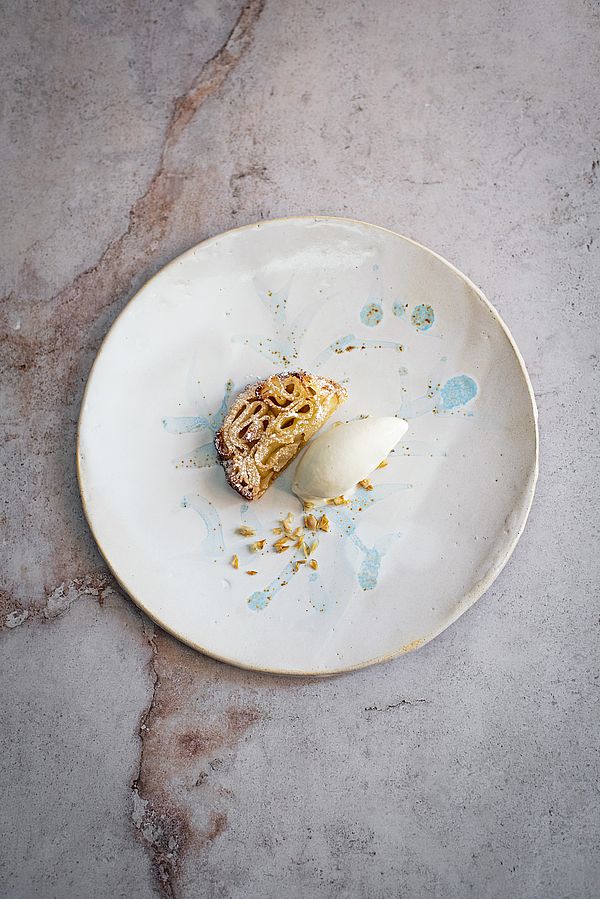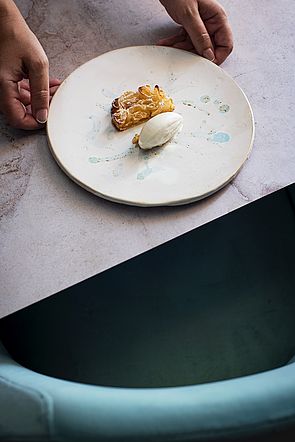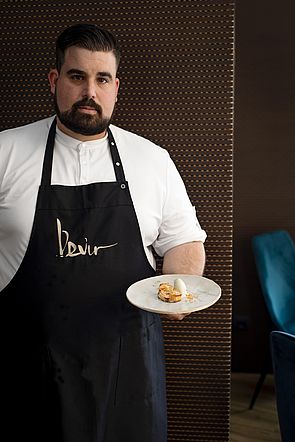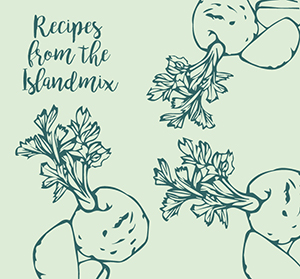For the tart
2 Valleseco pippin apples
1 San Mateo celery root
250 ml Granja Flor Valsequillo milk
2 Granja Avícola de Teror egg yolks
30 gr sugar
1 fresh vanilla stick
1 dessert spoon of icing sugar
5 grams of corn flour
1 puff pastry sheet
For making ice cream from apple and celery root cuttings
40 gr apple cuttings
20 gr celery root cuttings
15 gr sugar
1 squeezed lemon
50 ml water

For the tart
Mix up the egg yolks, sugar, milk, vanilla and corn flour to make the custard. Whisk the sugar with the milk and vanilla and heat to 50 degrees. Once this temperature is reached, remove from the heat and add the egg yolks, stirring constantly. Finally, add the corn flour and stir until it thickens.
Peel the apples and celery root. Cut into thin slices. Blanch all the slices and set aside.
Meanwhile, roll out the puff pastry and cut into circles of about 10 cm. Spread the cold pastry cream onto the puff pastry circles. Lay the celery root slices flat on top of the cream and place the apple slices on top to provide volume.
Bake the tart at 220 degrees for 24 minutes. Once done, remove from the oven and sprinkle with icing sugar.
For the ice cream
Mix all the ingredients together, blend and infuse for a minimum of 12 hours. Strain and pass through a sorbet maker.
If you do not have a sorbet maker, the ice cream can be made in the traditional way, putting the mixture in the freezer and stirring the mixture several times every 10 minutes, until an ice cream texture is achieved.
Present half of the cake on the plate, and on a bed of the chef's choice (in this case the treated fish scales used in other preparations has been used), then add a scoop of ice-cream.


“Many gastronomic gems from our island have gone into making this dish. The large apple from Valleseco, together with eggs from the Teror poultry farm, and vegetables and milk from local livestock, mean that this dessert represents Gran Canaria almost in its entirety ”, the chef explains
“This recipe is perfectly in keeping with our way of cooking, using Km0 or locally sourced products in its entirety, with hardly any waste ”.

‘Dish-enhancing’ secret ingredient
Celery root
or radish root is a lesser grown crop but is locally produced in a number of the island's agricultural estates, especially on organically farmed farms. It can be purchased at traditional farmers' markets such as the market in San Mateo. Commonly used in French cuisine, in creams, soups and salads, celery root is a large, low-calorie edible root, similar in flavour to celery, but perhaps sweeter.